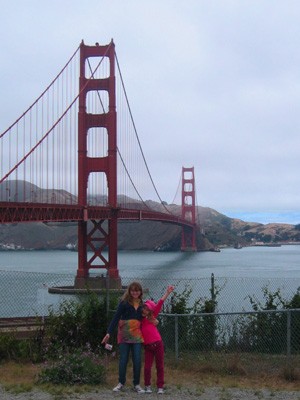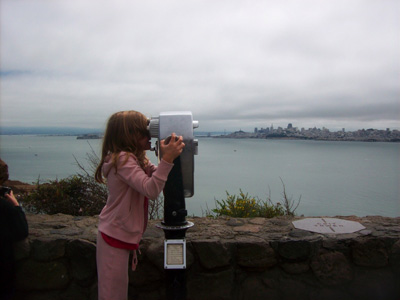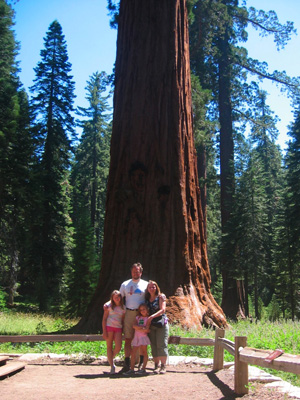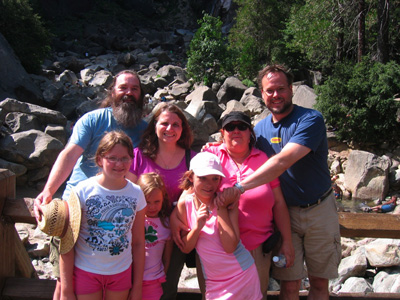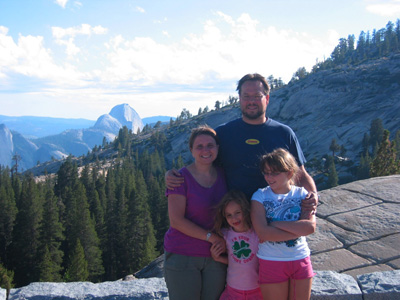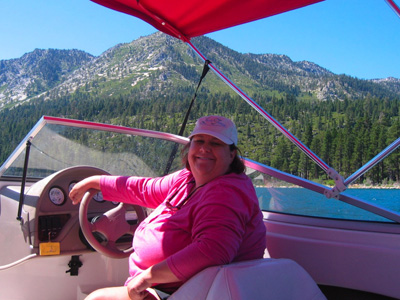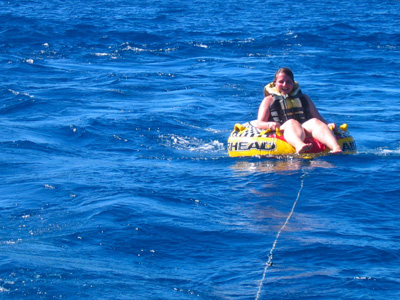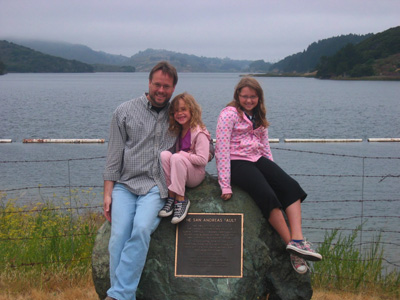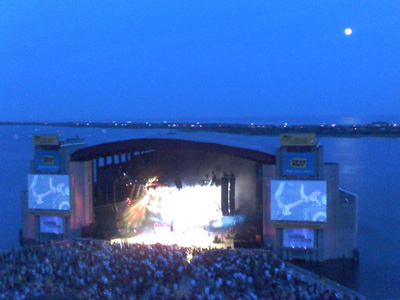International origami master Eric Joisel passed away over the weekend. I was a big admirer of his work, truly some of the most detailed and expressive origami ever created. Eric came to paperfolding from a background as a sculptor in clay and wood, had a highly developed style both thematically and aesthetically, and was particularly adept at human figures, faces and characters. You can see some of the best of his work at: ericjoisel.com.
Author: Zingblog 2
Buzzy Tonic on CD Baby
Face The Heat, the new CD from Buzzy Tonic is now on sale at CD Baby at (http://www.cdbaby.com/cd/buzzytonic) So go over there and buy yourself a copy, and a few to give to your friends. If you already have a copy, do me a favor and review the album and help me get some word of mouth going. While your at it, go ahead and pick up a copy of Buzzy Tonic’s first disc, The Brothers Zing (http://www.cdbaby.com/cd/brotherszing).
I also update my music pages to link to teaser versions of the songs, just the first minute or too, to give all y’all further incentive to go and buy the CD.
Colored Lights Can Hypnotize
My friend Leo Villareal is an artist who works in the medium of flashing LED’s. I’ve known him since grad school when he was just getting started with this stuff, and I did some programming on one of his light shows a while back. Yesterday CNET ran an article about him and his work, including an new exhibit at the San Jose Museum of Art. Leo’s a brilliant and kind guy, and it’s good to see him getting to this level of success and recognition.
California Pics
Okay, here you go. Five galleries of pics of our trip to California, plus a few upfront to whet you appetite. As always the family and friends fotoz are password protected, so contact me if you need the password. Enjoy!
http://zingman.com/fotooz/2010-01/index.html
http://zingman.com/fotooz/2010-02/index.html
http://zingman.com/fotooz/2010-03/index.html
http://zingman.com/fotooz/2010-04/index.html
http://zingman.com/fotooz/2010-05/index.html
Patent Troll From Beyond the Grave
On the heels of my trip to California my former employer is making news, back from the dead after ten years as an undead patent troll, a Patent Lich, if you will.
Way back in the 90’s I worked at the secretive, futuristic think tank Interval Research, owned by the reclusive “accidental billionaire” Paul Allen. It was a very cool place to work, brimming with cutting edge technology and great, creative people and their ideas. Their self-declared mission was to become the next Xerox PARC and the place was loaded with the best and brightest from the aforementioned PARC as well as the MIT Media Lab, the Interactive Telecommunications Program at NYU, and of course Stanford and lots of other places. Douglas Coupland described it in Microserfs as “the coolest place in Silicon Valley.” To me it was kind of like getting a PhD, but earning a real salary instead of accumulating academic accolades. Lots of real good interdisciplinary collaboration with lots of interesting, smart people.
However, the lab has a fatal flaw: hubris. Not satisfied with merely doing cutting edge R&D, their goal was to create startups and change the world and profit wildly, to spawn the next Apple or whatever. I was invited to join the research staff partially on the strength of the work I had done at NYU/ITP, using a programming language called Body Electric to build virtual worlds. This software morphed into a thing called Bounce under the guidance of my friend and mentor Levitt, and made its way to Interval, where it collided with a project from MIT called MediaCalc to create something new and really pretty amazing, particularly for the time, when digital video on a computer barely worked at all, even for the most specialized, high-end rig you could build. Both Bounce and MediaCalc used the idea of a graphical dataflow programming interface to create multimedia applications. Bounce was focused on realtime control and simulation environments that included animation and music. MediaCalc was more focused on generating data streams of metadata from audio and video input and recombining them for new, novel outputs.
At one point I was asked by the Biz Dev group what I thought the commercial applications of our work might be. The Biz Dev people were somewhat removed from the R&D group and the cultural divide was one of the lab’s big flaws. To me the answer was obvious: create a commercial tool for new media artists. Bear in mind that at this time Director and Premiere were still pretty new, as well as their now-defunct competitor MTropoils. Flash hadn’t been invented yet. Pixar was known only to a handful of geeks for being the company that made Renderman, an app that let you farm out our your rendering to a network of SGI’s if you were lucky enough to have that kind of thing. A lot of people there were academics, and were not interested in running a startup anyway. I’d worked at a few small companies before and to me the idea that you start with one core strength and build from there seemed natural. However, I was told that making authoring tools “isn’t a Paul Allen sized idea.” Apparently they wanted to go straight from zero to Toy Story which, needless to say, turned out to be unrealistic.
Meanwhile the world wide web happened, and as the dotcom bubble came to its busting point the lab seemed a little out of sorts. While we were making big investments in deep technology that would come to fruition in the future, the world changed around us. For example, one project got killed when Apple and Sony adopted FireWire rather than our data bus. By 1999 it seemed like anyone with a half-baked business plan could cruise up Sand Hill Road and get a zillion dollars for their startup without any particular technology or protectable IP. Remember pets.com? Interval continued to pursue R&D and indeed filed many patent applications, but never succeeded in launching a killer startup. My guess is that the top twenty coolest things from the lab will never see the light of day and will remain known only to a handful of insiders. One example: there was a guy there named Tom Etters who was working on a complex-plane Boolean logic for quantum computers called Link Theory, based the premise of the square root of not.
By early 2000 Microsoft was on trial for criminal practices with regard to numerous antitrust laws (basically they illegally strangled and killed Netscape), and the day the verdict came down (guilty, but just a slap on the wrist) Paul lost over a billion dollars (on paper anyway) due to the tumble in the price of Microsoft stock. This, in my mind, was the trigger that started the whole dotcom collapse and shawnuff in the next few months everything fell apart. Paul, always wanting to be ahead of the curve, wasted no time and immediately shut down Interval and about a half a dozen other companies of his. The ghost of Interval was subsequently reanimated to “maintain and exploit” its patent portfolio.
Last Friday Interval announced it was suing Google, Apple, and basically all of Silicon Valley for patent infringement. I haven’t read the patents yet, but it sounds from the press release that some of it may be based on my work. How funny. I understand the law of the land may well be on their side, and it’s unlikely that they’d have launched the suit if they didn’t have the patents to back it up, but I still think it’s kind of a dick move. Interval had a more then a decade to develop technologies and businesses based on their prototypes, but they didn’t, so now, years later, they’re crying someone stole their ideas.
Interval joins Viacom on the list of companies I work or have worked for that are suing Google. Unlike Interval, I feel the Viacom’s case is much more in the right philosophically, even if Viacom is the most ironic of champions to the cause. For some reason, Google has gotten away with legitimizing piracy of music, video, etc., where others have been smacked down. The project I was working on my last year at Interval relied heavily on media content sharing and was effectively killed by the Napster decision. Now Viacom is clearly an 800 pound monopolistic media conglomerate here, but at stake really is the ability of anyone working as an artist to get paid for their work in the future world of mainstream media. So the world is changing again. It’ll be interesting to see how it all plays out.
Bear Flag Republic Part III: Tahoe
We got into Tahoe Wednesday night (felt like a Sunday to us). The next morning we took it easy and hung around the house. Wanda’s family has a cabin up there which we’ve been to many times. Tahoe is our favorite place to go skiing (our next trip out to California will surely be in the winter), but there’s lots to do there in the summer too. We rented a power boat for one afternoon and cruised around the lake. We went into Emerald Bay and Wanda, the kids and I hopped off the boat and swam to an uninhabited rocky islet with the relic of a castle at the top. The water was cold and the air was thin, and Michelle, even thought she was wearing a life vest, was nervous and clingy, which made it hard for me to swim. Wanda coaxed Michelle to swim toward her, and once Michelle let go of me she realized she could float and swim no problem, which made things a good deal easier for me. We climbed up to the castle on the top of the island, which was pretty cool. We spent the rest of the afternoon tubing – one person riding in an inner tube towed behind the boat. It was a fabulous time. Once everyone had had their fill we went back to the marina and hit the bar. It seemed the trip was complete and things couldn’t get any better.
That night we went out dinner and afterward Jeannie and Wanda went to the casinos on the Nevada side. I’ve never been a big gambler myself, except for a stint when I first moved out to Silicon Valley and had a friend from M.I.T. who had been part of their famous card counting club and was starting a local chapter in Palo Alto. I learned the system and did well enough when we were practicing in his house, but when I got to a real casino the dealers were trained to never leave cards face up a moment longer than necessary, so simply getting a look at all the cards was the hardest part. It soon came to feel like hard work and not any fun, and so I gave up blackjack. I still had some fun at roulette, but my pattern is to bet only on single numbers so I either win big or run out of money in a hurry. Jeannie on the other hand, likes to play the slots and is good at losing slowly, making $20 or whatever last a whole evening. This night she got lucky and won a few hundred dollars, a great surprise to be sure!
The last day there we went out to breakfast, hiked around the waterfront and played a few more games of Dominion. Drove back over the pass into the central valley and back to SF. Shortly after we left, Wanda spotted a bear walking thru their yard! We got back to SF in time to go up to Coit Tower, although the cold and fog were still in effect. Had one last dinner on Pier 39 at Jeannie’s favorite seafood restaurant and replenished our pilfered chocolate.
Our final morning we had time for one more sightseeing jaunt. We took a walk down to San Andreas lake, along a trail in Burlingame, near the airport. Jeannie and I had happened upon this place our vary first visit out to California shortly after we got married, so the place has a special memory for us, and closed the trip with a nice symmetry. I’ll have to compare or recent pix to the ones we took all those years ago.
We got to the airport in good time, although the lines were plenty long. For some reason (traveling with children maybe) they let us to the front of the line for security. We had time to get lunch at the airport – chowder in a sourdough bread bowl. Then when we got to the gate they upgraded us to business class, which meant extra-big seat, and another lunch, and some really good wine.
Next up: pictures
…
Back in the world it’s much too real. Things at my job have gone from completely chaotic to somewhat more organized but under high pressure to make up for lost time. I recently updated my resume but decided to wait until September to start looking for a new job, mainly because I’m taking most of my time off in the summer and so it’s a bad time for it. Now the end of this long slog may be in sight, so I’m somewhat hopeful things could get back to normal soon. The day after tomorrow we’re doing a release candidate build. We’ll see how things play out.
Bear Flag Republic Part II: Yosemite
Once we got away from the Bay Area the weather started getting hot, up to 100 degrees as we crossed the Central Valley. As we drove up into the mountains the weather cooled to merely hot and the scenery grew more spectacular. On the way into the valley we stopped at Bridal Veil falls, one of several that spill down over the surrounding cliffs.
We met up with our friends Wanda and Chris in Yosemite Valley where we spent a couple days camping. Wanda and Chris are really excellent people, generous, funny and intelligent. I first met Wanda at a SIGGRAPH years ago when her business card read Director of Chaos. We all became good friends when I moved out to California and now they have a daughter about Michelle’s age. We stayed in Housekeeping Camp, a campground of tent-cabins peculiar to Yosemite. You can’t leave food in your tent because to the bears, so every campsite is provided with a food storage locker built like a mailbox. Since we came by plane W&C brought a cooler with cool things as well as some extra blankets and other sundries.
It was late afternoon by the time we arrived, and it took a while to get checked in and set up. Still the girls had time for a swim in the Merced River and then we went off to dinner. I’m used to cooking our own food when we go camping, so even though I’ve been to Yosemite before, it still feels weird (but good) to go out to eat. National parks aren’t your local state campground, so there’s all sorts of lodges, hotels and restaurants. We went to the cafeteria in Curry Village, which was quite good. The kids enjoyed riding around on the bus. Finally we came back to the campsite, built a fire and talked well into the night.
The next day (technically a Tuesday but Second Saturday by our reckoning) we headed down to Mariposa Grove to see the giant sequoias. There was construction on the narrow, winding mountain road, so the thirty mile trip took almost two hours. But it was totally worth it! We took a tram ride to the upper groove figuring the hike would be a lot for the kids, but hopped off on the way back and hiked down the last half. Saw lots and lots of really, really, really big trees, many of them thousands of years old. Truly staggers the imagination.
On the way back we stopped for lunch at the Wawona Hotel, a hundred-year old wooden lodge house in the park. When we got back to camp we went for another swim in the river. This time I went in and I can tell you the water was cold! That evening we had dinner in the Mountain Room at Yosemite Lodge, a fairly fancy restaurant. Chris and Wanda are big gamers and that night they introduced us to Dominion, a card game a bit like Magic but more streamlined and without all the annoying card collecting. MIchelle lost a tooth that night!
The next day (logical Sunday) we did all kinds of activities in the valley. Checked out the nature center at Happiness Isles and then went for a nice hike among a series of rocking, branching creeks. Checked out the Indian Village and (of course) the gift shop, and wound up the day at Yosemite Falls, where the kids had great fun climbing over rock and boulders at the base of the falls. W&C had bikes with them, so we split up and took turns biking aound the valley between stops.
As we were packing to go, Jeannie discovered something had chewed a hole thru a corner of her backpack! She had forgotten the tin of chocolates we bought in Marin. Even though they were sealed in shrink-wrapped plastic, some critter had sniffed them out. We found the plastic wrapper but not a trace of the tin or the chocolates. We can only guess as to what kind of creature did such an act. Lizzy speculated it was evils squirrels, but I’ve never heard of squirrels hitting a target that big. My conjecture was Otter-Bears, a mysterious animal that is rumored to live in rocky caves in mountain creeks. Michelle said it was a deer with fingers. But Jeannie and most other sensible people think it was probably raccoons.
We left the park in late afternoon, driving over Tioga pass and getting up to 10,000 feet. On the way we stopped at Olmstead Point (named after the famous park designer; not sure what he was doing way out west) and was a view of the valley looking back from the very top. The scenery for the whole drive (another 2 hours to go 30 miles kind of trip) was unbelievably beautiful, just breathtaking. Snow still lingered on some of the north slopes of the mountain tops. We came out of the Sierra on the Nevada side, into the dessert at Lake Mead. Then it was a long but relatively flat cruise north thru endless cattle ranches. Finally we headed back into the mountains as nightfall neared, headed up to Lake Tahoe. More on that in Part III.
Bear Flag Republic Part I: San Francisco
We just got back from a fantastic and epic vacation to California, including San Francisco, Yosemite National Park, and Lake Tahoe. The California Republic always seemed like a mythic land to me growing up in the cold northeast, and the years I lived there were some of the best times of my life. I’m glad I had the chance to go back and share it with my kids, and I’m happy that the land has lost none of it’s enchanting character and charm.
The week leading up to the trip was busy as things tend to be. In addition to the usual work and trying to beat the heat, Denis and Sarah were in town for a visit. Jeannie and the girls and I met them for lunch in Times Square Tuesday. It was nice and the kids won a bunch of Dora schwag in a promotion and gave it to my niece Anna. I’ve been working with Blick to get our outsourced development set up. More on that in a future post. Wednesday I flew thru the week’s yardwork including pulling weeds from under the hedges, as we’d be gone the coming weekend.
We got up way early Friday to catch an 8:00 AM flight. The whole getting to the airport and onto the plane process went smoothly. I meant to nap on the plane, but wound up getting into the book I was reading. We got a great view of Yosemite from the plane, a nice bit of foreshadowing. The first thing we did when we got there was cruise down to Silicon Valley to check out our old haunts. We had lunch in a burrito place near Jeannie’s old job, drove by old house in Redwood City and in Palo Alto, past my old office and the hospital where Lizzy was born, and few other landmarks. We ended up the tour by parking near Stanford parcel B and hiking up the hill to the big radiotelescope. We didn’t make it all the way to the dish because the kids were tired but we got high enough to get a good view of the bay.
Our hotel was near the airport in South San Francisco. It was nice enough and conveniently located. The big surprise was the weather. Just as in NYC it’s been super hot, in SF it’s been cool, to the point where they haven’t really had a summer. It was in the 50’s and 60’s and foggy the entire time we were there. That evening we went into the city and had dinner at Fisherman’s Wharf at one of the seafood restaurants. The kids loved all the silly tourist trap stores – magnets, posters, socks, left handed things. We got a bunch of seashells at the place where they sell seashells by the seashore. They also dug the sea lions, although the population there is still low compared to what it’s been. I guess they’ve swum south until the weather breaks.
Saturday the plan was to go the Exploratorium. On the way we stopped at the vista point on the SF side of the Golden Gate Bridge. The kids got their national park passports stamped there for the first of many times. The Exploratorium itself was a lot of fun. An interactive science museum full of hands-on exhibits, it had lots of cool stuff to explore about geometry, physics, color, sound, light, magnetism, etc. We ended up spending the whole day there until it closed at 5:00. There was even some origami stuff including a couple models by our friend Robert, and book in the gift shop called Origami American Style by John Montroll. I have to ask him if it’s legit; I’d never heard of it and it’s not from his regular publisher.
After the museum closed we walked around the Palace of Fine Arts and the pond and gardens. Then we drove up to twin peaks (the highest point in SF) to try and take in the view. We could see the radio towers from below, but by the time we got to the top of the hill the clouds had closed in and the view was just a cold windy white sheet. On the way down again we stopped at a park near Haight-Ashbury that had a hilltop just a bit lower. This was below the clouds and so we had a great view of the city and the bay and a fun little hike.
We ended up the evening back at Fisherman’s Wharf and dined at a different seafood restaurant. On the way we happened across an arcade of antique and classic coin-op machines ranging from Pac-Man and Galaxian back to 100-year-old player piano mechanical orchestras with built-in wind and percussion sections. Those were really fun and if I ever get silly rich I’m gonna buy me one.
On the way out of that we encountered a waterfront naval museum. This was something I always wanted to check out when I lived there but never got around to it. The kids wanted to take the tour for the submarine, and so we did. It was really cool. A 300-foot long, diesel-powered WWII vessel, it was crammed from stern to stem machinery and living quarters. Unbelievable to think 80 or so men could live in such a confined space. Even the officer’s quarters were very cramped. Not a good place to be if you’re over 6 feet tall.
Sunday we drove across the Golden Gate and spent the day in the Marin Headlands. Hiked around a bunch of places with excellent view of the bay and SF. Went out to the lighthouse at Bonita Point, across a swaying footbridge on which only two people at a time are allowed to cross. The sun came out for a spell and all was deep bright azure! Went to Rodeo beach and dipped our feet in the cold, cold Pacific Ocean. Walked up another trail to look down on the ocean from the cliffs. Bought a tin of chocolate in one of the gift shops because I liked the design on the box. Once we had our fill of hiking we cruised down to Sausalito and had snack by waterfront and enjoyed the scene at the harbor for a while.
For dinner we met up with friends Japantown. There was a street fair with Cuban bands going on when we arrived. We went by the Paper Tree, an amazing origami supply store, but it was closed. We walked around the Japantown mall, and we checked out the various stores, with the kids looking for hamster erasers (I don’t know, they’re some thing from Japan) and me looking at anime robot kits and samurai swords. The kids bought some Totoro dolls and I got a neat little paper robot kit. Not exactly origami, but related. Had an excellent dinner that included sushi, tempura and fried baby octopus. Finished the evening the hotel hot tub.
Monday we began the bear-oriented part of the trip. After stocking up on supplies we lit out for the famous Yosemite National Park. Jeannie and I had been there a few times while we lived in California, including one unforgettable trip in the winter in which we cross-country skied Badger Pass the whole time. We’d also been there a couple times in the fall, but this was our first trip in high summer and the first time for the kids. It’s a really fantastic place with just mind-boggling scenery, perhaps number one of any place I’ve ever been (or maybe a close second to the Grand Canyon) in terms of sheer geological grandeur and epic scale. More on that in Part II.
Face The Heat – Final Masters
Here they are at long last. I’m happy to announce that the final masters for my record, Face the Heat, now complete. Many thanks to Erik Blicker and all at G&E Music. You can listen to the tracks here, but only for a limited time. Once I get CD’s made and for sale on CD Baby and the iTunes store, I’ll change the links to be just 30-second-ish samples.
Heat Wave – 5:31
Fine Red Wine – 4:47
Earthbound (I Wanna Fly) – 5:08
Who Can Fool Me – 3:19
Making Miles – 5:11
Touch the Ceiling – 6:30
Green Glove – 3:42
The Nine – 4:07
Angel Or Alien – 8:12
Rush Concert
Jeannie and I saw the epic Canadian power trio Rush at Jones Beach Amphitheater last weekend. Rush is one of my all-time favorite bands and just about tied with the Grateful Dead for having seen them the most times. But last time I saw them was in 2004 or so, and before that it was many years. Rush are enjoying something of a revival these days, consolidating their legacy as it were, and touring in support of a (really good) documentary DVD about their career rather than an actual album.
Jones Beach is a really cool place to see a show. It’s situated right on the shore in a state park, with the stage out over the water. It was another super hot day, but as we crossed the bridge onto the island, the evening breeze was coming off the ocean and cooled everything down nicely. As the band started to play the moon rose over the stage. Very dramatic. After the concert Jeannie and I took a nice walk around the beach.
The show itself was great. Rush still have the chops and the energy to really deliver. Geddy Lee can hit those high notes, although didn’t do it as much. He sang a lot of parts lower and saved his voice for where it really mattered. They played two sets which spanned most of their career and included a bunch of newer stuff, and man they have a lot of records. I didn’t really know all of the tunes from the 90’s and 00’s. They played a bunch of brand-new songs from their forthcoming record, which sounded awesome. In particular “Caravan” had a lot of complex unison parts that evoked some of their earlier work. I think they tried to hit pretty much every record, but they skipped Fly By Night, Caress of Steel and Grace Under Pressure. This last one is one of my favorites, so that was a bit of a disappointment. Still, they played a lot of great material. Spirit of Radio, Freewill, 2112. Closer to the Heart included an excellent acoustic solo guitar intro.
They opened the second set with the whole of Moving Pictures, introduced by a spoof video of making a music video of “Moving Pitchers”. They were clearly having fun with it. Camera Eye was a definite high point; I’ve never seen them do that song live before. Encores included La Villa Strangiato, but with the first section played in a hockey-organ style, followed by a reggae version of Working Man. The walk-out music was a polka version of Closer to the Heart that would have done Weird Al proud. (The intermission music was Yes from Time and a Word.)
Rush music is fun to play as well as listen to. Back in college I did bunch of their songs in a band, playing synthesizers, including Subdivisions and YYZ. More recently I learned Xanadu and Cygnus X-1 on the bass, and now I’m learning Closer to the Heart on guitar.

